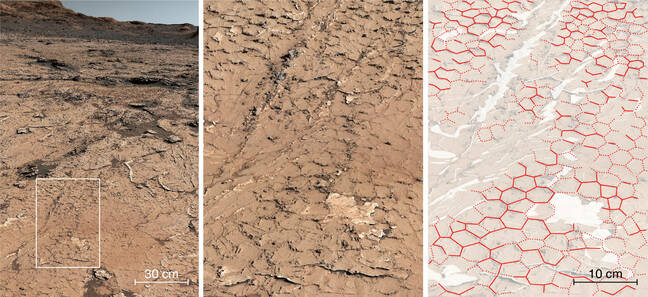Curiosity finds evidence of wet and dry seasons on ancient Mars
Scientists: Martian mud cracked in a manner that only happens after repeated cycles of drying
The Mars Curiosity rover continues to make discoveries that shed light on the early days of the Red Planet, this time having found evidence that the unforgiving dust world once experienced seasonal weather patterns and flooding.
The evidence came from photographs snapped by the NASA bot of the dry, dusty Martian surface marked by a series of hexagonal shapes that indicate mud covered the surface before drying and cracking.
The patterns Curiosity spotted showed junction angles of around 120 degrees, otherwise known as Y junctions, that only occur after repeat cycles of wet and dry.

Shapes in the mud on Mars that suggest wet and dry seasons ... Click to enlarge. Source: NASA/JPL-Caltech/MSSS/IRAP/Rapin et al/Nature
"In experiments, using clay layers, joint angles progressively tend towards 120° after 10 consecutive dryings with more cycles required to reach a homogeneous distribution centered at 120° and mature patterns of hexagonal shapes," scientists studying the snaps noted in a paper, which was published in Nature this week.
The cracks themselves are mere centimetres deep, which the boffins said suggests short wet-dry cycles "were maintained at least episodically in the long term," which would be yet another favorable condition for the past emergence of life on Mars.
"Wet periods bring molecules together while dry periods drive reactions to form polymers. When these processes occur repeatedly at the same location, the chance increases that more complex molecules formed there," said paper coauthor Patrick Gasda of the Los Alamos National Laboratory's Space Remote Sensing and Data Science group.
If the right organic molecules were present, "it's the perfect place for the formation of polymeric molecules required for life, including proteins and RNA," Gasda said.
Mount Sharp discoveries continue
Curiosity has made numerous water-related discoveries since arriving in the sulfate-bearing region of Mount Sharp in Mars' Gale Crater last year.
- Think International Space Station dust is obviously free of bad chemicals? Wrong
- NASA to test potential 400Mbps laser link for Mars
- We need to be first on the Moon, uh, again, says NASA
- NASA, DARPA enlist Lockheed to build nuclear-powered spacecraft
Shortly after it reached that area in October, Curiosity spotted popcorn-textured nodules containing minerals that suggested the prior presence of water, and then in February it clocked rippled rocks in the region that suggested the area was once lapped by waves. Further evidence of landslides potentially signaled rivers flowed down Mount Sharp from elevations beyond where Curiosity has traveled.
More recently, the newer Perseverance Mars rover found evidence of large, high-energy rivers flowing through the Jezero Crater area - another sign that Mars was once wet and possibly filled with life of some kind.
Repeated wet-dry cycles like those discovered by Curiosity, the scientists said, is another nail in the coffin for theories that Mars experienced a "monotonically declining water supply in the aftermath of an asteroid impact or a single volcanic eruption."
Recent theories have suggested that early Martian microbes may have changed the atmosphere drastically enough that Mars cooled until no longer able to support life. Drastic cooling in turn caused Mars' core to freeze, its magnetic field to dissipate, and its atmosphere to evaporate, or so the theory goes. ®
 Biting the hand that feeds IT
Biting the hand that feeds IT